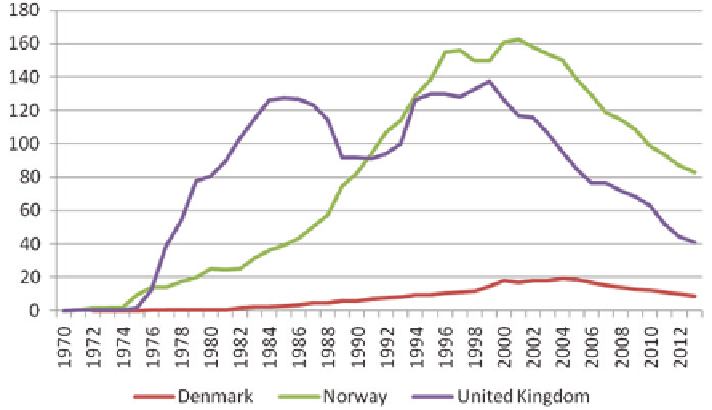Environmental Engineering Reference
In-Depth Information
Fig. 3
Oil extraction (in mln t) from under the North Sea bed in 1970-2013 (BP
2014b
)
extraction fell to 8.7 million tonnes. It must be noted that if those three countries
wanted to keep the extraction level at the 2013 rate, their resources at hand would
be used up within ten years. This state becomes a universal norm. Analysts esti-
mate that peak oil has been reached in 55 out of 64 countries extracting conven-
tional oil sources (Gilbert and Perl
2010
).
The opponents of peak oil theory point out (Maugeri
2012
; Yergin
2013
) that its
assumptions are wrong and, in fact, M.K. Hubbert was wrong determining peak
oil for America. What is more, the resources of oil are not declining. There are still
countries which constantly increase extraction (among others Canada, Brazil,
Saudi Arabia, UAE, Qatar, Kazakhstan
5
) or, like the USA, are again increasing
extraction. It appears that studying statistical data available does prove the oppo-
nents of the theory right, but only to a certain extent. The USA reached peak oil in
1970 (533.5 million tonnes) and the extraction started to decline, in spite of new
oil fields being developed (Alaska, the Gulf of Mexico), to hit rock the bottom in
2008 (302.3 million tonnes), when the extraction level started to rise rapidly again
to reach 446.2 million tonnes in 2013. It became possible only because of shale oil
extraction and increasing deepwater oil drilling, whereas extraction from conven-
tional sources is constantly deceasing.
Therefore, M.K. Hubbert was not mistaken about the conventional sources of
oil. It was, in fact, impossible to extract from non-conventional sources in 1950s,
5
Iraq has been constantly increasing oil extraction since 2005, although the case of Iraq is
extremely difficult to examine in the context of
peak oil
as the country has been at war since the
beginning of the conflict with Iran in 1980-1988, and a later embargo and occupation after the
2003 war.

Search WWH ::

Custom Search